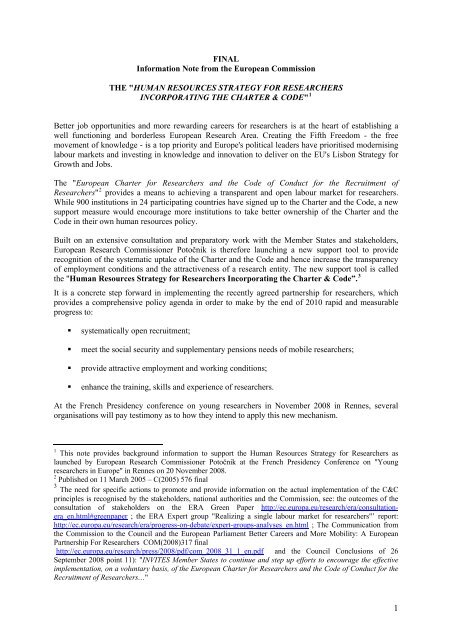Human resources strategy for researchers incorporating ... - Eurosfaire
Human resources strategy for researchers incorporating ... - Eurosfaire
Human resources strategy for researchers incorporating ... - Eurosfaire
You also want an ePaper? Increase the reach of your titles
YUMPU automatically turns print PDFs into web optimized ePapers that Google loves.
FINAL<br />
In<strong>for</strong>mation Note from the European Commission<br />
THE "HUMAN RESOURCES STRATEGY FOR RESEARCHERS<br />
INCORPORATING THE CHARTER & CODE" 1<br />
Better job opportunities and more rewarding careers <strong>for</strong> <strong>researchers</strong> is at the heart of establishing a<br />
well functioning and borderless European Research Area. Creating the Fifth Freedom - the free<br />
movement of knowledge - is a top priority and Europe's political leaders have prioritised modernising<br />
labour markets and investing in knowledge and innovation to deliver on the EU's Lisbon Strategy <strong>for</strong><br />
Growth and Jobs.<br />
The "European Charter <strong>for</strong> Researchers and the Code of Conduct <strong>for</strong> the Recruitment of<br />
Researchers" 2 provides a means to achieving a transparent and open labour market <strong>for</strong> <strong>researchers</strong>.<br />
While 900 institutions in 24 participating countries have signed up to the Charter and the Code, a new<br />
support measure would encourage more institutions to take better ownership of the Charter and the<br />
Code in their own human <strong>resources</strong> policy.<br />
Built on an extensive consultation and preparatory work with the Member States and stakeholders,<br />
European Research Commissioner Potočnik is there<strong>for</strong>e launching a new support tool to provide<br />
recognition of the systematic uptake of the Charter and the Code and hence increase the transparency<br />
of employment conditions and the attractiveness of a research entity. The new support tool is called<br />
the "<strong>Human</strong> Resources Strategy <strong>for</strong> Researchers Incorporating the Charter & Code”. 3<br />
It is a concrete step <strong>for</strong>ward in implementing the recently agreed partnership <strong>for</strong> <strong>researchers</strong>, which<br />
provides a comprehensive policy agenda in order to make by the end of 2010 rapid and measurable<br />
progress to:<br />
systematically open recruitment;<br />
meet the social security and supplementary pensions needs of mobile <strong>researchers</strong>;<br />
provide attractive employment and working conditions;<br />
enhance the training, skills and experience of <strong>researchers</strong>.<br />
At the French Presidency conference on young <strong>researchers</strong> in November 2008 in Rennes, several<br />
organisations will pay testimony as to how they intend to apply this new mechanism.<br />
1 This note provides background in<strong>for</strong>mation to support the <strong>Human</strong> Resources Strategy <strong>for</strong> Researchers as<br />
launched by European Research Commissioner Potočnik at the French Presidency Conference on "Young<br />
<strong>researchers</strong> in Europe" in Rennes on 20 November 2008.<br />
2 Published on 11 March 2005 – C(2005) 576 final<br />
3 The need <strong>for</strong> specific actions to promote and provide in<strong>for</strong>mation on the actual implementation of the C&C<br />
principles is recognised by the stakeholders, national authorities and the Commission, see: the outcomes of the<br />
consultation of stakeholders on the ERA Green Paper http://ec.europa.eu/research/era/consultationera_en.html#greenpaper<br />
; the ERA Expert group "Realizing a single labour market <strong>for</strong> <strong>researchers</strong>"’ report:<br />
http://ec.europa.eu/research/era/progress-on-debate/expert-groups-analyses_en.html ; The Communication from<br />
the Commission to the Council and the European Parliament Better Careers and More Mobility: A European<br />
Partnership For Researchers COM(2008)317 final<br />
http://ec.europa.eu/research/press/2008/pdf/com_2008_31_1_en.pdf and the Council Conclusions of 26<br />
September 2008 point 11): "INVITES Member States to continue and step up ef<strong>for</strong>ts to encourage the effective<br />
implementation, on a voluntary basis, of the European Charter <strong>for</strong> Researchers and the Code of Conduct <strong>for</strong> the<br />
Recruitment of Researchers…"<br />
1
Key features<br />
The <strong>Human</strong> Resources Strategy <strong>for</strong> Researchers is a mechanism to support research institutions'<br />
implementation of the Charter & Code. It should help to overcome the lack of public in<strong>for</strong>mation on<br />
the actual compliance with the principles and consequently increase the objective in<strong>for</strong>mation on the<br />
attractiveness of the research institution concerned and thus give them the international visibility they<br />
merit.<br />
This mechanism is a support tool. It is thus voluntary. It is also light to apply and flexible in its<br />
validation and verification approach. The result should be reliable in<strong>for</strong>mation which is easily made<br />
available to the public at large. The underlying characteristics of this mechanism there<strong>for</strong>e are:<br />
Implementation by individual institutions on a voluntary basis;<br />
Based on institutional self-assessment with full respect <strong>for</strong> the autonomy of the institutions<br />
Simple and light, non-bureaucratic and flexible, recognizing the variety of situations across<br />
institutions<br />
Transparency, providing easy, publicly accessible in<strong>for</strong>mation on the actions by undersigning<br />
institutions to implement the Charter and Code principles<br />
Implementation steps:<br />
An internal analysis by the research institution, involving all key institutional players, to<br />
compare institutional practices against the Charter and Code principles;<br />
The publication of planned actions <strong>for</strong> improvements in compliance (what, by when, by<br />
whom) through a <strong>Human</strong> Resources Strategy <strong>for</strong> Researchers <strong>incorporating</strong> the Charter &<br />
Code;<br />
The acknowledgement of the <strong>Human</strong> Resources Strategy <strong>for</strong> Researchers by the European<br />
Commission;<br />
The implementation of the <strong>Human</strong> Resources Strategy <strong>for</strong> Researchers" by the institution,<br />
which through its internal quality assurance mechanism also carries out a self-assessment at<br />
least every second year on the basis of which it may update its <strong>Human</strong> Resources Strategy as<br />
necessary;<br />
An external evaluation, which takes place periodically, but no later than every 4th year.<br />
All initiatives which comply with the key features and the institutional requirements in the<br />
implementation steps mentioned above may be considered as equivalent to the "HR Strategy <strong>for</strong><br />
Researchers", provided that they serve the same purposes with respect to the Charter & Code. Such<br />
measures can there<strong>for</strong>e also be acknowledged as a <strong>Human</strong> Resources Strategy <strong>for</strong> Researchers by the<br />
European Commission.<br />
For further in<strong>for</strong>mation on the "European Charter <strong>for</strong> Researchers and the Code of Conduct <strong>for</strong><br />
the Recruitment of Researchers" and the <strong>Human</strong> Resources Strategy <strong>for</strong> Researchers<br />
Incorporating the Charter & Code”: http://ec.europa.eu/euraxess/rights.<br />
2
Technical annex: The <strong>Human</strong> Resources Strategy <strong>for</strong> Researchers<br />
Annex<br />
A) The Charter & Code undersigning Research Institution (R.I.) makes an internal analysis,<br />
according <strong>for</strong> instance to a standard template ‘grouping’ all the 40 C&C principles in 4 areas<br />
(Ethical and professional aspects", "Recruitment", "Working conditions & social security", and<br />
"Training").<br />
The internal analysis is an assessment of rules and practices of the institution vis-à-vis the Charter &<br />
Code principles. For sake of transparency, the analysis has to involve all R.I. key players (i.e. Rector,<br />
HR Managers, <strong>researchers</strong>, etc.).<br />
If other HR initiatives of a similar nature are already in place within the institution, the "HR Strategy<br />
<strong>for</strong> Researchers" could be easily embedded in them. Thus, other tools than the suggested standard<br />
template <strong>for</strong> the internal analysis may be used, provided that the same type of in<strong>for</strong>mation as the<br />
internal analysis is collected (relevant legislation, current practices, actions required, when/by whom).<br />
The use of indicators' systems and Staff Opinion Surveys is recommended, as they are helpful to<br />
implement the HR <strong>strategy</strong> according to institutional and national rules and practices. Some illustrative<br />
examples are provided 4 .<br />
B) The institution publishes on its website its "<strong>Human</strong> Resources Strategy <strong>for</strong> Researchers,<br />
<strong>incorporating</strong> the Charter & Code principles". This is expected to summarise the main results of<br />
the internal analysis and to present the actions the institution intends to carry out to implement<br />
the C&C principles.<br />
A clear commitment to carry out internal (within the institution) and external awareness raising<br />
actions on the Charter & Code principles should be included in the HR Strategy.<br />
This step concretely corresponds to filling in and publishing the columns reserved to items Actions<br />
required" and "When/Who" of the recommended template referred to under item A (or a similar<br />
approach if the institution uses another template). Only the main results of the internal analysis should<br />
be published, while internal/confidential in<strong>for</strong>mation is obviously not included.<br />
C) Provided that the above steps are <strong>for</strong>mally respected, the European Commission<br />
"acknowledges" that the undersigning institution has adopted a <strong>Human</strong> Resources Strategy <strong>for</strong><br />
Researchers <strong>incorporating</strong> the Charter & Code".<br />
The acknowledgment by the European Commission would be based on a rapid (via IT tools) <strong>for</strong>mal<br />
check of the respect of the procedure. This check focuses on whether the publication of the HR<br />
Strategy is based on an internal analysis and the involvement of relevant actors. Publishing the<br />
institution's <strong>Human</strong> Resources Strategy on the European EURAXESS Rights Webpage 5 marks the<br />
acknowledgement by the European Commission.<br />
4 For instance: the University of Camerino internal analysis template<br />
http://www.unicam.it/sgq/Round_table/Template_internal_analysis.pdf<br />
and the University of Bristol survey http://www.survey.bris.ac.uk/support/news/services-to-help-with-yourwork<strong>for</strong>ce-surveys<br />
5 http://ec.europa.eu/euraxess/index_en.cfm?l1=0&l2=3<br />
3
D) The research institution implements its HR Strategy and conducts a self-assessment within<br />
the context of its internal, existing Quality Assurance mechanisms. Based on the self-assessment,<br />
the HR Strategy <strong>for</strong> Researchers is up-dated as necessary and published on the institution's<br />
website and the European EURAXESS Rights Webpage.<br />
In order to avoid cumbersome procedures, the self-assessment should be simple; this means to e.g. update<br />
the recommended template, when used or any equivalent one. No additional reports are required.<br />
The self-assessment is made with regular periodicity and in any case at least every 2 nd year.<br />
E) External evaluation: at least every 4 years, the institution prepares a short (e.g. 4 pages)<br />
report, showing the progress made towards the objectives of its HR Strategy <strong>for</strong> Researchers<br />
and its compliance with the C&C principles. The report is evaluated either by a panel of<br />
external reviewers or through national Quality Assessment (QA) mechanisms, such as National<br />
Evaluation Agencies or peer reviews.<br />
The choice between the national QA mechanisms, external reviewers or any other appropriate<br />
mechanism is made either at institutional or national/regional level. The evaluation should at least<br />
focus on the coherence between the HR Strategy and the actions carried out. The following minimum<br />
evaluation criteria should apply: impartiality, independence; confidentiality.<br />
If the evaluation is positive, the European Commission's acknowledgment is confirmed. If there are<br />
reservations from the evaluators regarding actual progress, recommendations <strong>for</strong> improvements within<br />
a reasonable timeframe are given to the Research institution.<br />
If, it emerges that no adequate actions to implement the recommendations are undertaken, the<br />
acknowledgment by the European Commission will be withdrawn.<br />
* * *<br />
This supporting tool is voluntary and flexible. It does not change the eligibility or selection criteria <strong>for</strong><br />
participation in FP7. Where similar initiatives are undertaken at national or other level (as <strong>for</strong> example,<br />
the "UK Concordat to Support the Career Development of Researchers" 6 ), these mechanisms may be<br />
considered as equivalent to the "HR Strategy <strong>for</strong> Researchers", provided that they serve the same<br />
purposes with respect to the Charter & Code and some key requirements are met. In particular, in<br />
addition to the <strong>for</strong>mal endorsement of the C&C principles, these initiatives should include an<br />
institutional internal analysis vis-à-vis the C&C, the results of which (including the planned actions)<br />
should be made public; the implementation of the planned actions is self-assessed and then every 4 th<br />
year an external evaluation should take place.<br />
6<br />
http://www.researchconcordat.ac.uk/ . In the UK Concordat there is explicit endorsement of the C&C<br />
principles.<br />
4
















